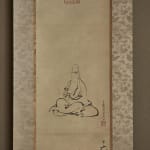Sakai Hōitsu (1761–1828)
Daily Paintings of Kannon: Day 16
Ink on silk, hanging scroll
Dated the 16th day of the 5th month, 1824
Seal: Uge-anshu
84 x 26 cm
176 x 42 cm (overall)
Further images
According to the inscription of the seal, this is one of a series of thirty-three works painted over the fifth month of 1824. This picture was painted on day sixteen. Four other works from the series are also known to exist. They all feature similar depictions of the White-robed Kannon. In that year, the fifth month had twenty-nine days, so if the project began on the first day of the fifth month, it would have finished on the fourth day of the sixth month. The thirty-three paintings correspond to the thirty-three forms assumed by Kannon (the White-Robed Kannon being one such form). This White-robed Kannon is reportedly based on a painting once owned by Hoitsu. That painting is also one of a series of daily depictions of Kannon, purportedly by Minamoto no Sanetomo. A comparison of the two works does reveal a basic similarity of form, though Hoitsu has also added his own idiosyncratic touches rather than just slavishly copying. The small face and the expressions of the eyes and nose are rendered meticulously using a thin brush. In contrast, the garments are depicted with thicker, flowing curves. These graceful curves are a major characteristic of Hoitsu’s works. They can also be found in the garments of other Hoitsu depictions of the White-robed Kannon and so on. These curves are not restricted to clothing either, as evinced by the way Hoitsu uses them to depict autumn grasses naturally swaying in the wind in his folding screens of autumn flowers. Note the upturned splashes of ink at the end of every brush line. These upticks also feature in Hoitsu’s signature and they lend this work a calligraphic air, almost as if the painting is composed of Japanese syllabic characters and Chinese characters.
Sakai Hoitsu (painter, haiku poet; 1761–1828)
Also known as Kishin; Keikyo-dojin; Oson; Uge-an; Toryo; etc.
Painter and haiku poet in late Edo period. Younger brother of the lord of Himeji domain, Sakai Tadazane. Adopted son of the 18th head priest of Higashi honganji, Monnyo Shonin. His real name is Tadanao. Learned shasei (direct observation from life) technique from So Shiseki, and studied ukiyo-e painting and techniques from the Kano, Tosa, and Maruyama schools. Eventually admired Ogata Korin. Added sensitive and emotional expression to Rimpa school’s decorativeness, which was established as his own style.
Sakai Hoitsu (painter, haiku poet; 1761–1828)
Also known as Kishin; Keikyo-dojin; Oson; Uge-an; Toryo; etc.
Painter and haiku poet in late Edo period. Younger brother of the lord of Himeji domain, Sakai Tadazane. Adopted son of the 18th head priest of Higashi honganji, Monnyo Shonin. His real name is Tadanao. Learned shasei (direct observation from life) technique from So Shiseki, and studied ukiyo-e painting and techniques from the Kano, Tosa, and Maruyama schools. Eventually admired Ogata Korin. Added sensitive and emotional expression to Rimpa school’s decorativeness, which was established as his own style.







